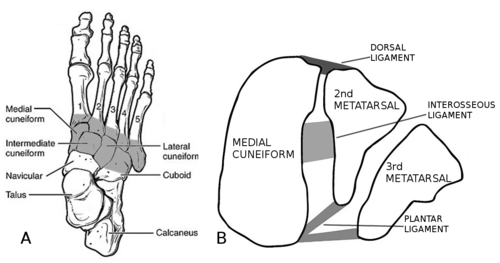Intertarsal and Tarsometatarsal Joints: Difference between revisions
No edit summary |
No edit summary |
||
| Line 2: | Line 2: | ||
[[File:lisfranc joint.png|thumb|right|500px|A, dorsal view of the bones of the foot, with the shaded area showing the relationship between the metatarsals and the tarsal bones forming the TMT joint complex. The 1st to 3rd metatarsals are associated with the respective three cuneiforms, while the 4th and 5th metatarsals articulate with the cuboid. | [[File:lisfranc joint.png|thumb|right|500px|A, dorsal view of the bones of the foot, with the shaded area showing the relationship between the metatarsals and the tarsal bones forming the TMT joint complex. The 1st to 3rd metatarsals are associated with the respective three cuneiforms, while the 4th and 5th metatarsals articulate with the cuboid. | ||
<br/>B, Cross section showing the Lisfranc ligament in relation to the medial cuneiform, 2nd metatarsal and 3rd metatarsal. The Lisfranc ligament consists of three distinct ligaments: the dorsal ligament, interosseous ligament and plantar ligament, with increasing respective strength <ref name="solan">Solan, M. C., Moorman, C. T., Miyamoto, R. G., Jasper, L. E. & Belkoff, S. M. Ligamentous restraints of the second tarsometatarsal joint: a biomechanical evaluation. Foot Ankle Int. 22, 637–641 (2001).</ref>.<br/>Image modified from an image by OpenStax College, distributed under a CC 2.0 license. Right image modified from an image by Mikael Haggstrom, distributed under a CC 2.0 License]] | <br/>B, Cross section showing the Lisfranc ligament in relation to the medial cuneiform, 2nd metatarsal and 3rd metatarsal. The Lisfranc ligament consists of three distinct ligaments: the dorsal ligament, interosseous ligament and plantar ligament, with increasing respective strength <ref name="solan">Solan, M. C., Moorman, C. T., Miyamoto, R. G., Jasper, L. E. & Belkoff, S. M. Ligamentous restraints of the second tarsometatarsal joint: a biomechanical evaluation. Foot Ankle Int. 22, 637–641 (2001).</ref>.<br/>Image modified from an image by OpenStax College, distributed under a CC 2.0 license. Right image modified from an image by Mikael Haggstrom, distributed under a CC 2.0 License]] | ||
The intertarsal joints | The '''intertarsal joints''' include the three cuneonavicular joints, the intercuneiform joints, the cuboideonavicular joint, and the cuneocuboid joint. The '''tarsometatarsal (TMT) joint complex''', known as the Lisfranc joints, is comprised of the five metatarsals, the three cuneiforms and the cuboid. | ||
The base of the second metatarsal is recessed into the midfoot, and forms a key-like configuration with the intermediate cuneiform. The rigid second metatarsal (and also so some degree the third) provides a central rigid structure to the longitudinal arch, allowing a rigid lever for push-off in late stance. | The base of the second metatarsal is recessed into the midfoot, and forms a key-like configuration with the intermediate cuneiform. The rigid second metatarsal (and also so some degree the third) provides a central rigid structure to the longitudinal arch, allowing a rigid lever for push-off in late stance. | ||
| Line 9: | Line 9: | ||
The Lisfranc ligament has an integral role in providing midfoot stability. It attaches from the medial cuneiform to the base of the 2nd metatarsal with its three segments. The TMJ joint complex is intrinsically stable because of the arch-like configuration which is best seen in cross-section. | The Lisfranc ligament has an integral role in providing midfoot stability. It attaches from the medial cuneiform to the base of the 2nd metatarsal with its three segments. The TMJ joint complex is intrinsically stable because of the arch-like configuration which is best seen in cross-section. | ||
== See Also == | |||
* [[Lisfranc Injury]] | |||
==References== | ==References== | ||
*Basic Biomechanics of the Musculoskeletal System - Nordin 4th edition 2012 | *Basic Biomechanics of the Musculoskeletal System - Nordin 4th edition 2012 | ||
[[Category:Foot and Ankle Anatomy]] | [[Category:Foot and Ankle Anatomy]] | ||
Revision as of 11:41, 18 July 2021

B, Cross section showing the Lisfranc ligament in relation to the medial cuneiform, 2nd metatarsal and 3rd metatarsal. The Lisfranc ligament consists of three distinct ligaments: the dorsal ligament, interosseous ligament and plantar ligament, with increasing respective strength [1].
Image modified from an image by OpenStax College, distributed under a CC 2.0 license. Right image modified from an image by Mikael Haggstrom, distributed under a CC 2.0 License
The intertarsal joints include the three cuneonavicular joints, the intercuneiform joints, the cuboideonavicular joint, and the cuneocuboid joint. The tarsometatarsal (TMT) joint complex, known as the Lisfranc joints, is comprised of the five metatarsals, the three cuneiforms and the cuboid.
The base of the second metatarsal is recessed into the midfoot, and forms a key-like configuration with the intermediate cuneiform. The rigid second metatarsal (and also so some degree the third) provides a central rigid structure to the longitudinal arch, allowing a rigid lever for push-off in late stance.
The motion of the first, fourth, and fifth tarsometatarsal joints are much greater than the second metatarsal. The first tarsometatarsal joint has approximately 10° of plantar flexion during late stance. There is negligible motion in other plantes of motion for these joints. The intertarsal joints are closely congruent with minimal gliding motion between each other.
The Lisfranc ligament has an integral role in providing midfoot stability. It attaches from the medial cuneiform to the base of the 2nd metatarsal with its three segments. The TMJ joint complex is intrinsically stable because of the arch-like configuration which is best seen in cross-section.
See Also
References
- Basic Biomechanics of the Musculoskeletal System - Nordin 4th edition 2012
- ↑ Solan, M. C., Moorman, C. T., Miyamoto, R. G., Jasper, L. E. & Belkoff, S. M. Ligamentous restraints of the second tarsometatarsal joint: a biomechanical evaluation. Foot Ankle Int. 22, 637–641 (2001).

